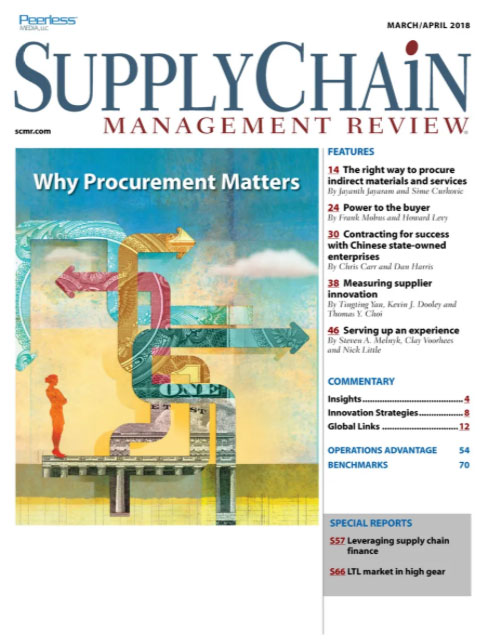Sorry, but your login has failed. Please recheck your login information and resubmit. If your subscription has expired, renew here.
March-April 2018
"Inflation creeps into U.S. Supply Chain.” So said the headline on a Wall Street Journal article I read this morning before writing this column. The Journal went on to write that U.S. companies are grappling with rising material and ingredient costs on top of pressure from higher wages—a potential double whammy— and noted that companies like Whirlpool and Ford have already issued warnings to the market. Browse this issue archive.Need Help? Contact customer service 847-559-7581 More options
Strategic sourcing can be a source of competitive advantage for those firms that do it right. Yet, the majority of articles on procurement best practices have centered on direct spend, or the raw materials and goods that go into manufacturing a product. Very little attention has been paid over the years to the indirect materials and services that are used internally by a firm, such as MRO, fleet management and utilities, even though a large firm may spend a billion dollars or more on this category (see sidebar for a definition of indirect spend).
In many respects, indirect spend is the neglected pet of a procurement organization, no one individual or entity is paying attention to the category. Or, as a commodity manager for a U.S.-based medical equipment manufacturer once summed it up in an industry magazine: “There was no focus on indirect spend. As a result, organizations learned to fend for themselves in the indirect spend categories, and everybody was doing their own idea of what they thought sourcing was.”
We found similar attitudes toward indirect procurement (what we’ll refer to as IP) during discussions with a number of IP executives through the course of our research into the state of indirect procurement (see sidebar: About our research). Their experiences can be summed up in three points:

This complete article is available to subscribers only.
Log in now for full access or start your PLUS+ subscription for instant access.
SC
MR
Sorry, but your login has failed. Please recheck your login information and resubmit. If your subscription has expired, renew here.
March-April 2018
"Inflation creeps into U.S. Supply Chain.” So said the headline on a Wall Street Journal article I read this morning before writing this column. The Journal went on to write that U.S. companies are grappling… Browse this issue archive. Access your online digital edition. Download a PDF file of the March-April 2018 issue.Strategic sourcing can be a source of competitive advantage for those firms that do it right. Yet, the majority of articles on procurement best practices have centered on direct spend, or the raw materials and goods that go into manufacturing a product. Very little attention has been paid over the years to the indirect materials and services that are used internally by a firm, such as MRO, fleet management and utilities, even though a large firm may spend a billion dollars or more on this category (see sidebar for a definition of indirect spend).
In many respects, indirect spend is the neglected pet of a procurement organization, no one individual or entity is paying attention to the category. Or, as a commodity manager for a U.S.-based medical equipment manufacturer once summed it up in an industry magazine: “There was no focus on indirect spend. As a result, organizations learned to fend for themselves in the indirect spend categories, and everybody was doing their own idea of what they thought sourcing was.”
We found similar attitudes toward indirect procurement (what we'll refer to as IP) during discussions with a number of IP executives through the course of our research into the state of indirect procurement (see sidebar: About our research). Their experiences can be summed up in three points:
SC
MR


Latest Supply Chain News
Latest Podcast

 Explore
Explore
Procurement & Sourcing News
- Strengthening customer fulfillment: Building a strategic stakeholder network
- Trump picks former Wisconsin congressman Sean Duffy for DOT secretary
- Made in Mexico, manufactured by China
- Retail sales see gains in October, reports Commerce and NRF
- Geopolitical readiness in supply chains: Strategic challenges for leaders
- With capacity to spare, logistics real estate demand remains subdued
- More Procurement & Sourcing
Latest Procurement & Sourcing Resources

Subscribe

Supply Chain Management Review delivers the best industry content.

Editors’ Picks





